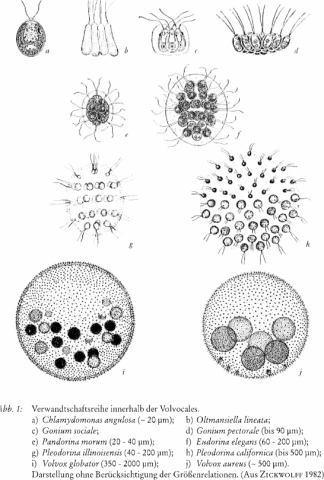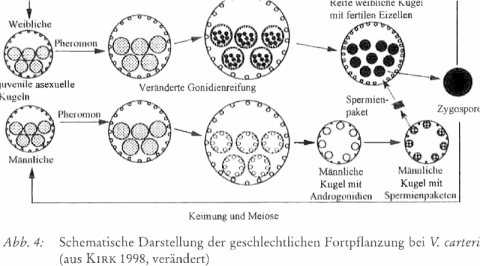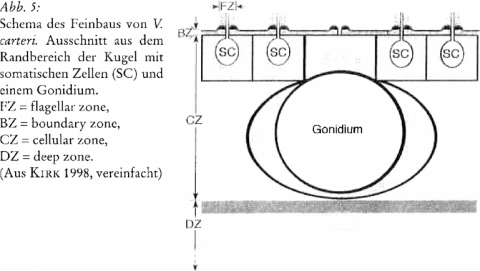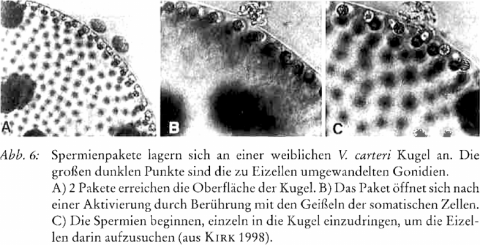Die Zunahme morphologischer und physiologischer Autonomie bei den Volvocales
Export Article Citation as
- Download price : €6
Abstract:
The increase of morphological and physiological autonomy with the Volvocales
The transition to multicellularity in early evolution led to an emancipation from the environment and to an increase of organismal autonomy. As a model for this principle, the Volvocales are studied. Within the green algae a sequence from single celled forms to colonies of Volvocales with different levels of integration and different cell numbers can be established. This sequence exhibits biological functions of an increasing autonomy such as the internalization of cells into a physiologically controlled extracellular matrix; the establishment of boundary structures; the internalization of germ cells and fertilization; the reduction of the surface area relative to volume; the enhancement of motility within the environment; the increase of metabolic autonomy and relative emancipation from direct availability of nutrients. Thus typical patterns of the generation of autonomy can be described, just as they are found within the transition to multicellularity in animals. It is stated that the principle is of central relevance for understanding macroevolution and it has so far been badly neglected in evolutionary theory.
References
- BELL, G. (1985): The Origin and Early Evolution of Germ Cells as Illustrated by the Volvocales. In: Halvorson, H. O. & Monroy, A. (Eds.), The Origin and EVOlution of Sex, pp. 221 - 256. New York
- BLUEWEISS, L., Fox, H., KUDZMA, V., NAKASHIMA, D., PETERS, R. & SAMS, S. (1978): Relationships between Body Size and Some Life History Parameters. Decologia 37: 257 - 272
- BONNER, J. T. (1965): Size and Cycles. An Essay on the Structure of Biology. Princeton
- BONNER, J. T. (1988): The Evolution of Complexity. Princeton University Press Princeton, NJ
- BONNER, J. T. (1995): Evolution und Entwicklung. Reflexionen eines Biologen. Vieweg Braunschweig
- DESNITSKI, A. G. (1993): On the Origins and Early Evolution of Multicellularity. BioSystems 29: 129 - 132
- DESNITSKI, A. G. (1995): A Review on the Evolution of Development in Volvox - Morphological and Physiological Aspects. European Journal of Protistology 31: 241 - 247
- ECKERT, R. (2000): Tierphysiologie. Thieme Verlag Stuttgart, New York
- GERHART, J. & KIRSCHNER, M. (1997): Cells, Embryos, and Evolution. Toward a Cellular and Developmental Understanding of Phenotypic Variation and Evolutionary Adaptability. Blackwell Malden MA
- GOLDSTEIN, S. F. (1992): Flagellar Beat Patterns in Algae. In: Melkonian, M., Algal Cell Motility, pp. 99 - 153. Chapman and Hall New York, London
- GRANT, V. (1985): The Evolutionary Process. A Critical Review of Evolutionary Theory. Columbia University Press New York
- HARRIS, E. H. (1989): The Chlamydomonas Source Book. Academic Press, San Diego
- HERRICK, C. J. (1946): Progressive Evolution. Science 104: 469
- HILDEBRANDT, G. (1973): Medizinische Rhythmusforschung. Universitas 28: 857 - 870
- HOEK, C. v. d., ]AHNS, H. M. & MANN, D. G. (1993): Algen. Thieme Verlag Stuttgart, New York
- HUXLEY, J. (1959): New Bottles for New Wine. Chatto & Windus, London
- IYENGAR, M. O. P. & Desikachary, T. V. (1981): Volvocales. Indian Councel of Agricultural Research, New Delhi
- KIPP, E. A. (1948): Höherentwicklung und Menschenwerdung. Hippokrates Verlag Stuttgart
- KIPP, E. A. (1949): Arterhaltung und Individualisierung in der Tierreihe. Verhandlungen der Deutschen Zoologen in Mainz 1949. Wiederabdruck in: Schad, W. (Hrsg.), Goetheanistische Naturwissenschaft, Band 3 (Zoologie), S. 7 - 11. Verlag Freies Geistesleben Stuttgart 1983
- KIRK, D. L. (1998): Volvox. Molecular-Genetic Origins of Multicellularity and Cellular Differentiation. Cambridge University Press Cambridge
- KIRK, D. L. (2000): Volvox as a Model System for Studying the Ontogeny and Phylogeny of Multicellularity and Cellular Differentiation. Journal of Plant Growth Regulation 191 265 - 274
- KOUFOPANOU, V. (1994): The Evolution of Soma in the Volvocales. The American Naturalist 143: 907 - 931
- LANGE, E. (1976): Ein Beitrag zur Frage »Was ist Höherentwicklung?« Biologische Rundschau 14: 206 - 214
- PICKETT-HEAPS, J. D. (1975): Green Algae. Structure, Reproduction and Evolution in Selected Genera. Sinauer Sunderland, Massachusetts
- PURCELL, E. M. (1977): Life at Low Reynolds Number. American Journal of Physics 45: 3 - 11
- RIEGER, R. & WEYRER, S. (1998): The Evolution of the Lower Metazoa: Evidence from the Phenotype. In: Müller, W E. (Ed.), Molecular Evolution: Towards the Origin of Metazoa, pp. 21 - 43. Heidelberg, Berlin
- ROSSLENBROICH, B. (2001): Das Verständnis des Organismus als zentrales Problem der Medizin. Forschcndc Komplemcntärmedizin 8: 125 - 136
- ROSSLENBROICH, B. (2004): Zur Evolution der organismischen Autonomie bei den frühen Metazoen. Elemente der Naturwissenschaft (in Vorbereitung)
- SCHAD, W. (1971): Säugetiere und Mensch - Zur Gestaltbiologie vom Gesichtspunkt der Dreigliederung. Verlag Freies Geistesleben Stuttgart
- SCHAD, W. (1982): Die Vorgeburtlichkeit des Menschen - Der Entwicklungsgedanke in der Embryologie. Verlag Urachhaus Stuttgart
- SCHAD, W. (1989): 150 Jahre allgemeine Zelltheorie der Organismen - Ihre Begründung und ihre Beendigung. Tycho de Brahe Jahrbuch für Goetheanismus 1989, S. 40 - 56. Niefern-Öschelbronn
- SCHAD, W. (1992): Der Heterochronie-Modus in der Evolution der Wirbeltierklassen und Hominiden. Dissertation Universität Witten/Herdecke
- SCHAD, W. (1997): Die Zeitintegration als Evolutionsmodus. Habilitationsschrift, Universität Witten/Herdecke
- SCHMITT, R., FABRY, S. & KIRK, D. L. (1992): In Search of Molecular Origins of Cellular Differentiation in Volvox and Its Relatives. International Review of Cytology 139: 189 - 265
- SENFT, W. H. & HUNCHBERCER, R. A. (1981): Temperature Dependence of Growth and Phosphorus Uptakc in Two Species of Volvox. Journal of Phycology 17: 323 - 328
- SIMPSON, G. G. (1971): The Mcaning of Evolution. Yale University Press New Haven, London
- SMITH, G. M. (1918): The Vertical Distribution of Volvox in the Plankton of Lake Monona. American Journal of Botany 5: 178 - 185
- SOMMER, U. & MACIEJ GLIWICZ, Z. (1986): Long Range Vertical Migration of Volvox in Tropical Lake Cahora Bassa (Mozambique). Limnology and Oceanography 31: 650 - 653
- STARR, R. C. (1980): Colonial Chlorophytes. In: Cox, E. R. (Ed.), Phytoflagellates, pp. 147 - 163. Elsevier Amsterdam
- STARR, R. C. (1984): Colony Formation in Algae. In: Liskens, H. F. & Helsop-Harrisson, J. (Eds.)‚ Encyclopedia of Plant Physiology, Vol. 17, pp. 261 - 290. Springer Verlag Berlin
- STEBBINS, G. L. (1969): The Basis of Progressive Evolution. University of North Carolina Press Chapel Hill
- STRASBURGER, E. (1991): Lehrbuch der Botanik. G. Fischer Stuttgart, Jena, New York
- SUMPER, M. & HALLMANN, A. (1998): Biochemistry of the Extracellular Matrix of Volvox. International Review of Cytology 180: 51 - 85
- UTERMÖHL, H. (1924): Tiefenwanderung bei Volvox. Schriften für Süsswasser- und Meereskunde 9: 731 - 754
- UTERMÖHL, H. (1925): I.imnologische Phytoplanktonstudien. Die Besiedlung ostholsteinischer Seen mit Schwebpflanzen. Archiv für Hydrobiologie (Suppl.) 5: 1 - 527
- VANDE BERG, W. & STARR, R. C. (1971): Structure, Reproduction and Differentiation in Volvox gigas and Volvox powersii. Archiv für Protistenkunde 113: 195 - 219
- VERMEIJ, G. J. (1999): Inequality and the Directionality of History. American Naturalist153:243 - 253
- WALKER, I. & WILLIAMS, R. M. (1976): The Evolution of the Cooperative Group. Acta Biotheoretiea 25: 1 - 43
- WEISS, P. A. (1977): The System of Nature and the Nature of Systems: Empirical Holism and Practieal Reductionism Harmonized. In: Schaefer, K. E., Hensel, H. & Brady, R. (Eds.), Toward a Man-Centered Medical Science. A New Image of Man in Medicine, Vol. 1. Futura Publishing Company New York
- WILLMER, P., STONE, G. & ]OI-INSTON, I. (2000): Environmental Physiology of Animals. Blackwell London
- ZICKWOLFF, G. (1982): Leben und Bewußtsein. Die Bedeutung der Absterbevorgänge im Organismus. In: Schad, W. (Hrsg.), Goetheanistisehe Naturwissenschaft, Band 1 (Allgemeine Biologie), S. 105 - 112. Stuttgart










